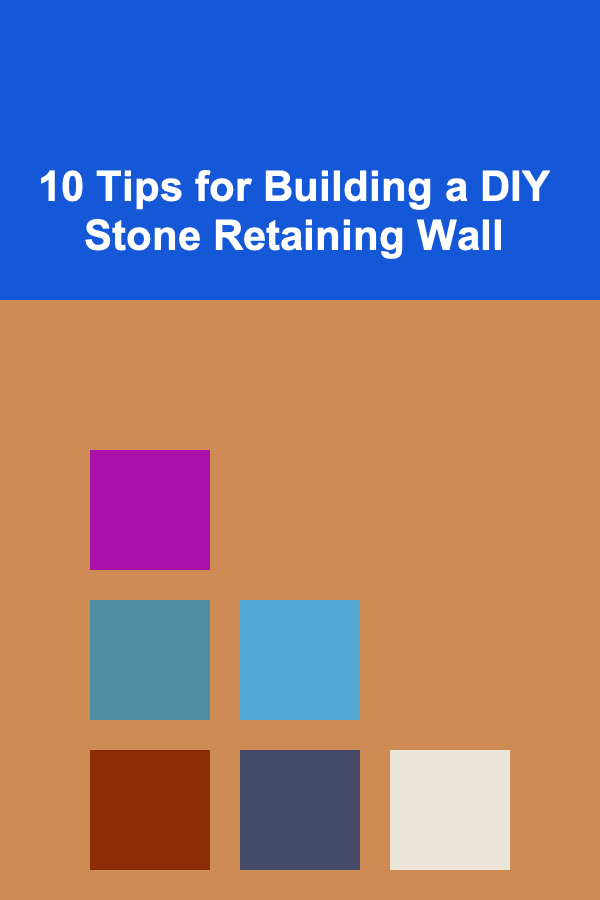
10 Tips for Building a DIY Stone Retaining Wall
ebook include PDF & Audio bundle (Micro Guide)
$12.99$7.99
Limited Time Offer! Order within the next:

Building a stone retaining wall is an ambitious yet rewarding project that can add structure and beauty to your landscape. Whether you're working on a garden, a slope, or simply trying to prevent soil erosion, a stone retaining wall can provide both functional and aesthetic benefits. The process may seem challenging at first, but with the right knowledge and preparation, you can create a durable and attractive feature that enhances your outdoor space.
In this article, we will explore 10 essential tips for building a DIY stone retaining wall. These tips cover everything from the planning stages to the construction process, ensuring that your wall stands the test of time while adding value to your home and landscape.
Understand the Purpose and Scope of the Wall
Before diving into the construction process, it's crucial to understand the purpose of your retaining wall and the scope of the project. Retaining walls can serve various purposes, such as preventing soil erosion, creating level terraces, or adding decorative elements to your landscape. The wall's purpose will determine its size, design, and construction requirements.
Purpose and Design Considerations:
- Erosion Control: If your wall is designed to prevent soil erosion, it will need to be built with proper drainage in mind to ensure that water doesn't accumulate behind it.
- Terracing: For landscaping purposes, you may want to create multiple terraces in your yard, and a retaining wall can help define each level.
- Decorative Features: Sometimes, retaining walls are built simply to enhance the aesthetic of a garden or patio area. In this case, the design of the wall might be more focused on appearance rather than structural integrity.
Understanding the exact purpose of the wall will help guide the materials you choose, the wall's height, and the overall design.
Plan for Proper Drainage
One of the most crucial aspects of building a retaining wall is ensuring proper drainage. If water is not able to escape from behind the wall, hydrostatic pressure can build up, which may cause the wall to fail over time. Therefore, drainage planning is essential for the longevity and safety of the wall.
Drainage Solutions:
- Weep Holes: Incorporate weep holes into the design of your wall. These small openings allow water to drain out from behind the wall, preventing pressure from building up.
- Drainage Pipe: Installing a perforated drainage pipe behind the wall is another effective way to ensure that water flows away from the wall's base.
- Gravel Backfill: Use gravel as backfill material behind the wall to help water filter through the wall and into the drainage system. This also helps reduce pressure on the wall.
Ensure that the drainage system is installed correctly during the construction of the wall to prevent costly repairs down the line.
Choose the Right Materials
Selecting the right materials is a key factor in building a successful stone retaining wall. There are various types of stone that can be used for retaining walls, each with its own pros and cons.
Common Stone Types:
- Natural Stone: This includes rocks like granite, limestone, and fieldstone. Natural stone can be more expensive and may require more labor to shape and fit, but it offers a timeless and natural look.
- Flagstone: Flagstone is a popular choice due to its flat, smooth surfaces that make it easier to stack and fit together. It works well for both dry-stack and mortared walls.
- Pavers: Pre-cast concrete pavers are another option. They are designed for easy installation, come in various shapes and sizes, and can mimic the appearance of natural stone.
When selecting your material, consider the size and height of the wall, the overall aesthetic you're aiming for, and the climate of your area (for instance, frost-resistant materials are important in colder climates).
Dig a Strong Foundation
The foundation is the most important part of your retaining wall. If the foundation is not solid, the entire wall could shift or fail over time. Digging a strong and stable foundation will provide the necessary support for the rest of the wall.
Foundation Considerations:
- Trench Depth: The trench for the foundation should be deep enough to accommodate a few inches of gravel and the first layer of stones. Typically, a depth of at least 6 inches is recommended for most walls, but this will depend on the size and height of the wall.
- Level Base: The base of the trench should be leveled to ensure that the first row of stones sits evenly. Use a level tool to check the foundation as you dig.
- Compacted Gravel: After digging the trench, fill the bottom with several inches of compacted gravel to provide a stable base for the wall stones. This gravel also promotes drainage.
Taking the time to dig a strong foundation will pay off in the long run, as it ensures that the wall remains stable and secure.
Start with a Solid First Layer
The first layer of stones is critical because it provides the foundation for the rest of the wall. If this layer is not level and well-set, the rest of the wall will be unstable.
Layering Tips:
- Large Stones First: Start with the largest and heaviest stones for the bottom layer. These stones will act as a sturdy base to support the rest of the wall.
- Check for Level: Use a level tool to ensure that each stone in the first layer is perfectly level both horizontally and vertically.
- Tight Fit: Arrange the stones so that they fit tightly together, minimizing gaps between them. If necessary, use a hammer and chisel to shape the stones to fit.
The more effort you put into making the first layer strong and level, the more durable your entire wall will be.
Use Proper Stacking Techniques
Building a retaining wall involves stacking stones on top of each other, and the way you stack them will impact the stability of the wall. It's important to follow a method that distributes the weight of the stones evenly and prevents the wall from shifting over time.
Stacking Tips:
- Backwards Slant (Batter): To create a sturdy wall, slightly tilt each layer of stones back towards the slope, known as the "batter." This technique helps ensure that the wall remains stable and doesn't lean forward.
- Overlap Joints: Just like laying bricks in a wall, overlap the joints between stones in each layer. This creates a more stable structure and prevents weak points in the wall.
- Avoid Gaps: As you stack stones, try to avoid large gaps between them. Use smaller stones to fill in any gaps and create a smooth, solid structure.
The more precisely you stack the stones, the more likely your wall will be strong and secure.
Use Mortar or Dry Stack Methods
Depending on the materials you're using and the style of the wall, you may need to use either mortar or a dry-stack method to hold the stones in place.
Mortar Walls:
- Application: Mortar is applied between the stones to create a solid, permanent bond. This is often used with larger stones or materials like flagstone or brick.
- Curing Time: Mortared walls require time to set and cure. Be sure to allow adequate curing time before applying weight or pressure to the wall.
Dry-Stack Walls:
- No Mortar: Dry-stacked walls rely on gravity and the tight fit of the stones to stay in place. This method is often used with natural stone or smaller stones.
- Flexibility: Dry-stack walls are easier to build and adjust, but they may require more frequent maintenance as stones can shift over time.
Choose the method that best suits your materials and the desired look of your wall.
Incorporate Drainage Materials Behind the Wall
Proper drainage is essential to prevent water from accumulating behind the wall, which can lead to erosion and the weakening of the structure. Adding drainage materials behind the wall will help direct water away from the foundation and reduce the risk of pressure buildup.
Drainage Materials:
- Gravel: Use a layer of gravel behind the wall to facilitate drainage. This will allow water to flow through the wall and out, reducing the pressure behind it.
- Geotextile Fabric: To prevent soil from mixing with the gravel, use geotextile fabric between the soil and gravel. This will allow water to pass through while preventing dirt from clogging the drainage system.
- Perforated Drainage Pipe: For larger retaining walls, consider installing a perforated drainage pipe behind the wall. This pipe will collect water and direct it away from the wall.
By ensuring proper drainage, you will help maintain the integrity and longevity of your wall.
Backfill and Compact as You Go
As you build your retaining wall, you will need to backfill with soil behind the wall. Proper backfilling ensures that the wall remains stable and does not shift or tilt over time.
Backfilling Tips:
- Backfill in Layers: As you add each layer of stones, backfill the space behind the wall with soil or gravel. Compact the backfill material as you go to prevent shifting.
- Use the Right Material: Use well-draining soil or gravel for backfilling. Avoid using clay or other materials that retain water, as they can increase the pressure behind the wall.
Proper backfilling helps create a strong and durable foundation for the wall while also improving drainage.
Finishing Touches and Maintenance
Once the wall is built, it's time to add the finishing touches. This may include adding decorative stones or plants around the base of the wall to integrate it into the surrounding landscape. Over time, it's essential to maintain your retaining wall to ensure it remains stable and visually appealing.
Maintenance Tips:
- Check for Shifting Stones: Periodically inspect the wall for any stones that may have shifted or become loose. If you notice any issues, repair them promptly to prevent further damage.
- Replenish Drainage: Ensure that your drainage system remains functional by checking the weep holes and drainage pipe regularly for blockages.
Maintaining your retaining wall will extend its life and keep it looking great for years to come.
Conclusion
Building a DIY stone retaining wall is a rewarding project that can enhance your outdoor space. By following these 10 tips---starting with understanding the purpose of the wall and finishing with proper maintenance---you can create a sturdy, functional, and beautiful structure. With careful planning, the right materials, and attention to detail, your stone retaining wall will not only protect your landscape but also add a natural and timeless element to your yard. Happy building!
Reading More From Our Other Websites
- [Organization Tip 101] How to Store Extra Hangers and Clothes Pins Efficiently
- [Home Storage Solution 101] How to Optimize Your Small Pantry Storage for Bulk Items and Infrequently Used Goods
- [Tie-Dyeing Tip 101] Beyond the Classic Swirl: 10 Creative Tie-Dye Patterns You Haven't Tried Yet
- [Organization Tip 101] How to Manage Your Home's Outdoor Inventory
- [Hiking with Kids Tip 101] Must-Have Supplies for a Children's Trail First-Aid Kit
- [Home Rental Property 101] How to Handle Legal Issues in Your Rental Property Business
- [Home Rental Property 101] How to Choose the Best Condos for Rent in Urban Areas
- [Personal Care Tips 101] How to Shave Properly with a Razor in the Winter to Avoid Dry Skin
- [Home Budget 101] How to Build an Emergency Fund: Essential Tips for Homeowners
- [Home Holiday Decoration 101] How to Decorate a Christmas Tree on a Budget: Stylish Yet Affordable Tips

Essential Financial Planning Tools Every Budgeter Should Know About
Read More
How to Create a Timeline Wall for Music Projects
Read More
How to Light Your Home for the Holidays with Budget-Friendly Ideas
Read More
How to Sell Your Digital Art Online
Read More
How To Safely Use Smart Wearables: A Comprehensive Guide
Read More
How to Plan a Web Design Project for Portfolio Websites
Read MoreOther Products

Essential Financial Planning Tools Every Budgeter Should Know About
Read More
How to Create a Timeline Wall for Music Projects
Read More
How to Light Your Home for the Holidays with Budget-Friendly Ideas
Read More
How to Sell Your Digital Art Online
Read More
How To Safely Use Smart Wearables: A Comprehensive Guide
Read More